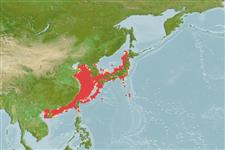>
Scombriformes (Mackerels) >
Scombridae (Mackerels, tunas, bonitos) > Scombrinae
Etymology: Scomberomorus: Latin, scomber = mackerel + Greek, moros = silly, stupid (Ref. 45335).
More on author: Cuvier.
Environment: milieu / climate zone / depth range / distribution range
Ekologi
laut; oceanodromus (Ref. 51243); kisaran kedalaman 0 - 200 m (Ref. 54883). Temperate; 45°N - 18°N, 108°E - 143°E (Ref. 54883)
Northwest Pacific: confined to the subtropical and temperate waters of China, the Yellow Sea and Sea of Japan north to Vladivostok, former USSR. Often confused with Scomberomorus munroi.
Size / Weight / umur
Maturity: Lm ? range ? - ? cm
Max length : 113 cm TL jantan/; (Ref. 116934); Berat maksimum terpublikasi: 8.0 kg (Ref. 116934)
Duri punggung (Keseluruhan (total)): 19 - 21; duri punggung lunak (Keseluruhan (total)): 15-19; Sirip dubur lunak: 16 - 20; vertebrata, bertulang belakang: 48 - 50. Interpelvic process small and bifid. Lateral line gradually curving down toward caudal peduncle. The only species in the genus with a straight intestine. Swim bladder absent. Body covered with small scales. Anterior quarter of first dorsal fin and a narrow distal margin of the rest of the dorsal fin black. Sides with seven or more rows of longitudinal spots on the sides; some spots connected together.
Found near shore (including semi-enclosed sea areas) (Ref. 11230). Undergoes a spawning migration in spring (March to June) and a feeding migration in fall (September to November) in the Inland Sea of Japan. Feeds on small fishes. Another major fishing gear that is used are set nets. This species is the most important Scomberomorus species in Japan which is cultured and released for fishery. Marketed fresh and especially tasty in winter. Eaten pan-fried, broiled and baked (Ref. 9988).
Collette, B.B. and C.E. Nauen, 1983. FAO Species Catalogue. Vol. 2. Scombrids of the world. An annotated and illustrated catalogue of tunas, mackerels, bonitos and related species known to date. Rome: FAO. FAO Fish. Synop. 125(2):137 p. (Ref. 168)
Status IUCN Red List (Ref. 130435)
ancaman kepada manusia
Harmless
penggunaan manusia
Perikanan: bernilai komersial tinggi; Budidaya air: komersial; Ikan buruan: ya
informasi lanjut
AcuanBudidaya airprofil budidaya airStrainGenetikaElectrophoresesDiturunkanPenyakit-penyakitPengolahanNutrientsMass conversion
Alat, peralatan
laporan khas
muat turun XML
Sumber internet
Estimates based on models
Preferred temperature (Ref.
123201): 13 - 24.5, mean 19.2 °C (based on 181 cells).
Phylogenetic diversity index (Ref.
82804): PD
50 = 0.5000 [Uniqueness, from 0.5 = low to 2.0 = high].
Bayesian length-weight: a=0.00288 (0.00155 - 0.00538), b=3.15 (2.97 - 3.33), in cm total length, based on LWR estimates for this species & (Sub)family-body (Ref.
93245).
Trophic level (Ref.
69278): 4.5 ±0.8 se; based on diet studies.
Generation time: 2.1 ( na - na) years. Estimated as median ln(3)/K based on 2
growth studies.
Daya lenting (Ref.
120179): sedang, Waktu penggandaan populasi minimum 1.4 - 4.4 tahun (K=0.7; Fec>100,000).
Prior r = 0.57, 95% CL = 0.37 - 0.85, Based on 1 stock assessment.
Fishing Vulnerability (Ref.
59153): Low to moderate vulnerability (34 of 100).
Climate Vulnerability (Ref.
125649): High vulnerability (58 of 100).
Nutrients (Ref.
124155): Calcium = 13.3 [4.9, 52.9] mg/100g; Iron = 0.325 [0.125, 0.917] mg/100g; Protein = 20.6 [19.1, 22.0] %; Omega3 = 0.47 [0.25, 0.94] g/100g; Selenium = 21.4 [6.2, 103.2] μg/100g; VitaminA = 8.35 [1.43, 54.86] μg/100g; Zinc = 0.31 [0.19, 0.53] mg/100g (wet weight); based on
nutrient studies.
